History As Stories
Prehistoric Rock Paintings Discovered in Columbia
I don’t know about you, but I feel hope and wonder when reminded that we don’t know/haven’t seen everything. Here’s a nice surprise for those who haven’t already seen it.
Archaeologists have uncovered 8 miles of wall paintings in Columbia that they estimate to be about 12,000 years old.
I’m not going to give all the details here because I’m including a bunch of links to articles. I’m doing it this way because the story needs the visuals. The photos, videos, and maps included in the articles (even if you don’t read the articles) give much needed perspective. And they’re so pretty!
I left the links in URL format so you can see the original website in case you want to pick and choose which you open.
Have fun!
https://www.inverse.com/science/newly-discovered-amazon-rock-art
http://www.bradshawfoundation.com/news/index.php?id=More-rock-art-discovered-in-Colombia
https://www.lonelyplanet.com/articles/colombia-prehistoric-rock-art
https://www.independent.co.uk/news/world/americas/colombia-rock-art-amazon-rainforest-b1763761.html
Bonnie and Grandpa?
I was watching a movie about Bonnie and Clyde the other night and took a quick look at their bios in Wikipedia. (If you use Wikipedia, feel free to toss a donation their way.)
Turns out that Bonnie Parker was born in 1910, just like my paternal grandfather, Ernest Hanson. It just struck me as strange because she is a figure kind of trapped in a past that includes Tommy guns and Fords with skinny tires.
While she died (I think I’m required to say “in a hail of bullets”) in 1934 at the age of 23, my grandpa lived to be 90 years old. He would have also been 23 at the time of Tommy guns and Fords, but went on to have seven children and a full life instead of the hail of bullets thing.
You can read and see photos here about my paternal grandparents and how their families were a new Viking invasion.
And I just noticed that Bonnie Parker was only 4’11” tall. That’s the same height as my mother!
Not sure I want to feel this many connections with Bonnie Parker, so I’m going to quit before I find anything else.
Libra Music
It’s time for a little music history!
Being born on October 13 makes these musicians Libras. Since my mother and both my sisters married Libras, I have a fondness.
Here are some tunes that you may or may not know by people that were born today. (Not sure why the videos didn’t embed, but you can click on the link.)
Born in 1941 is Paul Simon of Simon and Garfunkel fame. I have a lot of memories of their music, but since they don’t share a birthday, I’m going to stick with Paul. “Me and Julio Down By the Schoolyard” is my favorite of his solo efforts. Very catchy tune.
Lacy J. Dalton was born in 1946. I’m not very familiar with country music, but did find this video of “Tennessee Waltz” that I really like.
https://www.youtube.com/watch?v=_JZ5UoVfoGo&list=PLLip14OJNyyxDjMjgYPBoEZDMzsKfCGfW&index=18
And last on my list is Sammy Hagar, born in 1947. I like this song (“Eagles Fly”), and I love this video. Anytime I get to watch jets, my heart is happy.
I don’t know much about the zodiac except I’m sometimes told that I am such a Pisces. But I laughed like a loon when I saw that Lenny Bruce and Margaret Thatcher were both born on this day in 1925. The same exact day.
Life is strange.
Do You Have Stories About Party Line Telephone Service?
I was standing by the beach watching the sunset when a man (more than six feet away from me) took a call on his cell phone and carried on a personal conversation for quite a long time. He was speaking loudly to be heard over the waves, and I thought that I really didn’t want to know that much about his personal life. Then I realized that some people love to be able to eavesdrop on private calls and in the past had to rely on the party line.
A party line is a telephone line that you share with other homes. During and after World War II the lines used for telephones was expensive and not readily available. This was especially true in rural areas where the houses were far apart. Basically, a single phone line, dedicated to your home, was expensive. But if you shared that line, phone service was much more affordable. Many people could only afford to have a phone at all if it was a party line.
As is still true, affordability is sometimes inconvenient.
It was inconvenient to want to make a call and discover that someone else was on the line and you had to wait, and hope it wasn’t a long conversation. Teenagers before the age of texting actually liked talking on the phone. For hours. And hours.
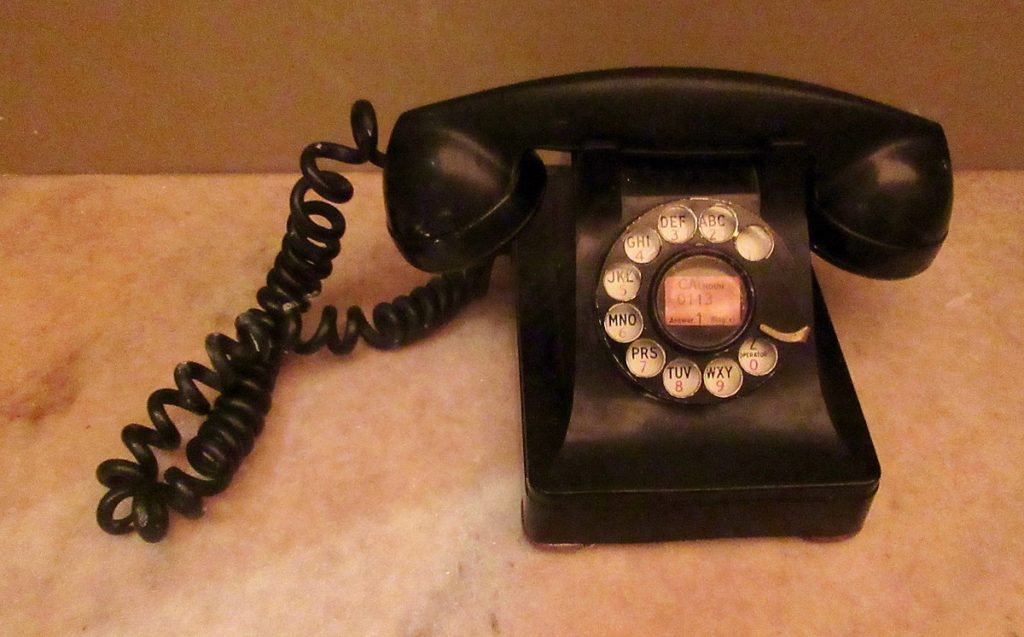
Maybe someone left their phone off the hook, making it impossible for anybody else on that party line to make or receive calls. Or imagine one of the parties was not home, but someone called them and let the phone ring and ring and ring. That call rings in all the homes that share that line and they all hear that ringing.
The guy by the beach sharing his personal call? That was one of the inconveniences of party lines. Since you shared a phone line, anyone on that party line could pick up the phone and listen to your conversations. I imagine many people thought of that as a form of entertainment and a good way to learn all the latest gossip.
I don’t remember ever having a party line, probably because we usually lived in housing on military bases. But I do remember visiting my grandparents in Minnesota and being told not to answer the phone because it wasn’t their ring. People on the party line had their own rings (1 long, 2 short, etc.) so they knew when the call was for them.
Because of all the possibilities for annoyance and rudeness, some areas distributed rules of etiquette, or common courtesy, that should be followed if you had a party line. It was all about playing well with others. These included recommendations to keep your calls short, and to space them out if you were making more than one call. Don’t listen to the conversations of others as that is totally rude.
One of the most obvious courtesies in my mind is that if someone gets on the line and says they have an emergency, you should get off the phone immediately so they can place their emergency call. Unfortunately, there were people who abused that courtesy both ways. In 1954 New York passed a law that you could be prosecuted for either refusing to get off the phone for an emergency, or falsely saying you had an emergency just so you could use the phone.
The last operating party line system was shut down in 1991.
I would really love to get comments from people who had party lines. Did you personally know all the others on your party line? How many were on your party line? I want to know what my readers think are the pros and cons of the party line system. I’m sure things that would annoy me now, were not seen as issues when the party line was either your only option, or your only affordable option.
Help me out, please!
Sharing Music (Old Music is History)
I love to learn new stuff, even if it’s not intentional. “Reaction videos”, judging by the number of hits when you plug that in your chosen search engine, are a big deal. You can watch people react to all kinds of things, but my chosen ones are music.
In these videos, people watch videos of songs they have never heard before and give their reactions. Sometimes it’s a genre of music they’ve never listened to before, but a lot of times it’s younger people listening to old music. I’m old enough that I know a lot of songs, so for me it’s more like listening to an old-fashioned mix tape.
Once the reactors have done a few videos and gotten a bit of an audience, they get requests for songs they should try. I don’t know if there are only a limited of people who watch these and make requests or if it has something to do with the algorithms that lead people to these videos from social media sites, but there are a lot of reaction videos about The Righteous Brothers and Queen.
Maybe the draw is the amazing quality of those voices. If you’re old enough that these two bands are not new to you, can you remember how you felt the first time you heard those voices? I mean, to be able to hear them for the first time again? That is some joyful stuff.
I’m not going to choose and link to reactors for you because finding your own favorites is half the fun. But I will link two great reaction songs.
This is my favorite song by The Righteous Brothers. It was released in 1966, which was 54 years ago. Only 11 years after the end of World War II. I was just a baby then. Ok, a toddler.
This Queen song was released in 1976, but most reaction videos seem to use this live version from Montreal in 1981. I graduated from high school in 1981, so this song is right in the time of my life when every song meant something and still brings up memories. Oh yeah, and it’s kind of funny how most of the reactions to this live version mention all the beer on the piano.
Check out some history in the form of music and your own memories. Think of your favorite band or song and plug the name and the word reactions into your preferred search engine.
Then even if it’s not your first time, close your eyes and listen as if it is.
An Adventurous Victorian Woman
Lucky for us, in terms of stories and knowledge, some women during the Victorian Era (1837-1901) broke free of the constraints limiting women and became explorers. Apparently the spirit of adventure and the lure of knowledge and freedom were (and still are) a powerful incentive.
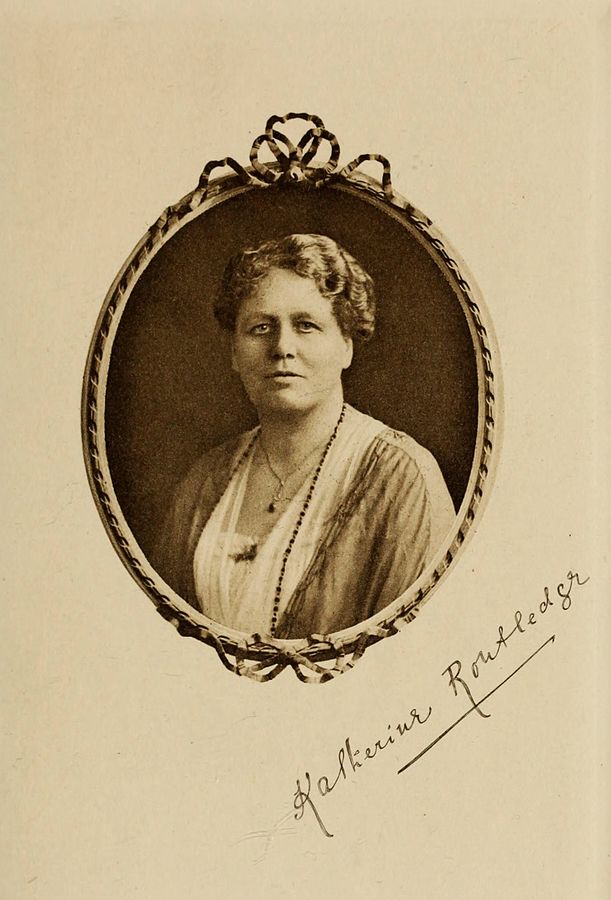
Katherine Routledge (1866-1935) grew up in a wealthy Quaker family in northern England. She graduated from Oxford in 1895, in her late 20s, after studying Modern History. She taught for a while and then traveled to South Africa.
In 1906, at the age of 39 or 40, she married anthropologist William Scoresby Routledge, and together they went to British East Africa to study the Kikuyu culture. Based on those studies, they published With a Prehistoric People in 1910.
Then they set their sights on another mostly unknown culture. They planned an expedition to Easter Island (Rapa Nui). They had a special yacht build and with a small crew set sail from England in 1913. It took them a year to get to the remote island.
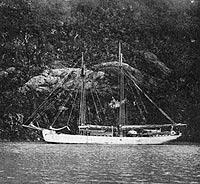
During their time on Easter Island they excavated and studied some of the mysterious stone statues (moai). To understand the moai, Routledge also interviewed the people about their culture as it was at that moment and as it had been in the past. To help understand the time frame of her visit, World War I began the year they reached Easter Island.
Routledge and her husband returned to England and in 1919, when she was in her early 50s, she published The Mystery of Easter Island: The Story of an Expedition. Besides sharing what she learned on the island, she also included the journeys to and from the island and the places they stopped along the way. In the early 20th century, travel books were all the rage.

Routledge kept her field notes, photos, drawings, and whatever else she would need to write a more scientific study about the culture of Easter Island. Although that never happened, Routledge’s book, papers, and artifacts in the Pitt Rivers Museum and the British Museum, are still studied by those interested in the people and moai of Easter Island.
There was a history of mental illness in Routledge’s family, and her brother had spent more than two decades in a sanitarium. Throughout the 1920s Routledge’s paranoid schizophrenia became increasingly debilitating. During that decade she and her husband split up and she became increasingly isolated. In 1929 her husband had her forcibly committed to a mental health facility. She died there at the age of 69 in 1935.
These are the barest of bare bones of her life, and if you would like to learn more about Routledge, or about the Victorian world she left, check out Among Stone Giants: The Life of Katherine Routledge and Her Remarkable Expedition to Easter Island by Jo Anne Van Tilburg. Van Tilburg has also written some articles here at the Easter Island Statue Project website about Routledge.
One last note to remind you of the world in which Routledge lived. There is a journal article in Folk=Lore: Transactions of the Folk-Lore Society titled “The Bird Cult of Easter Island”, which is from a paper read before the Society on May 16, 1917. The article is by “Mrs. Scoresby Routledge”.
New Book About the Texas Rangers (Not the Baseball Team)
It’s hard to do research during chaotic times, but I can still listen to podcasts without overloading my brain too much.

Texas Ranger monument in front of Texas State Capitol. Photo by
Daniel Mayer via Wikimedia Commons.
Today I listened to NPR‘s Fresh Air podcast, an episode called “The Brutal History of the Texas Rangers”. Click here to listen to the interview with Doug J. Swanson, the author of Cult of Glory: The Bold and Brutal History of the Texas Rangers, which will be available tomorrow.
We moved out of Texas when I was in the middle of third grade, and I don’t remember learning much about the Texas Rangers in any of the other schools I attended. Most of what I know if from novels, TV, and movies. It’s always difficult to know how much of that is true, but I was never interested enough to research.
I figure right now is either the exactly right time to read this book, or the exactly wrong time. I haven’t decided yet for myself, but you may want to give it some thought.
One last thing. One of the photos discussed in the interview is copyrighted so I can’t include it here. It’s an amazing snapshot of the time, with Jay Banks in the foreground and the school in the background. If you click here, it should show up as the first photo.
Spies, and Secrets, and Hair Bands…Oh My!
I love quest stories. Add in some spies and rock music and I’m all in.
I’ve mentioned before that I listen to podcasts a lot, whether they are continuous weekly or limited to telling one story in a limited number of episodes. At the moment I’m listening to one of the limited series, eight episodes, and wanted to share it with you all.
About a decade ago journalist Patrick Radden Keefe heard a story that the Central Intelligence Agency (CIA) wrote the German band Scorpions song “Wind of Change”. He recently decided to move that investigation to the top of his To Do list, which I prefer to think of as a Quest list.
I haven’t finished all eight episodes yet, but highly recommend you check this out. Spies, hair bands, secrets – what’s not to love? I grew up during the Cold War, so this seems like revisiting my youth. I even saw Scorpions live in the early 80s!
This podcast is a great way to get a new perspective on things that you thought you already understood. This song came out around the end of the Soviet Union, so it is interesting to hear how people in what used to be the Soviet Union think about the band and the song. Also fun to hear stories of how the CIA tried to influence culture in other regions.
You can binge all eight episodes on Spotify or have it drop weekly into your Apple podcast feed.
If you listen, I would love to know what you think about the series, so drop a note in the comments section. Happy listening and learning!
Science and Disease: Originally Titled “The 1854 London Cholera Epidemic, and My Brain on Research”
I originally wrote this post in 2016, but this is a good to time to put it out there again. I’ve made a couple of very minor changes that don’t effect the details of the story.
The stories I share with you on this blog are usually about more than the story, at least for me. I often find alternate ways to look at the story I’m researching, completely different topics suggested by the research I’m doing, and also personal connections to a particular story.
Today I want to share a story that I first heard years ago, but also let you know what it meant to me.
Cholera is a bacterial infection of the small intestine, which can be fatal. In the first half of the 19th century, tens of thousands of people in Great Britain died during cholera outbreaks. Unfortunately, most people believed that the cause of cholera was airborne.
Consider for a moment how any 19th century city would have smelled. There were humans and animals living crowded together, and with no sewer system, human and animal waste ended up in the streets and in the waterways. That waste was dumped into the River Thames, making it both their toilet and their source of drinking water. It’s hardly surprising that in the years before germ theory was discovered people believed the horrible stench could cause illness and death.
In 1854, there was a new cholera outbreak in Soho in London. Dr. John Snow, a physician of some renown, had suggested five years earlier that cholera could be transmitted by water rather than air. He now had the opportunity to test his hypothesis.
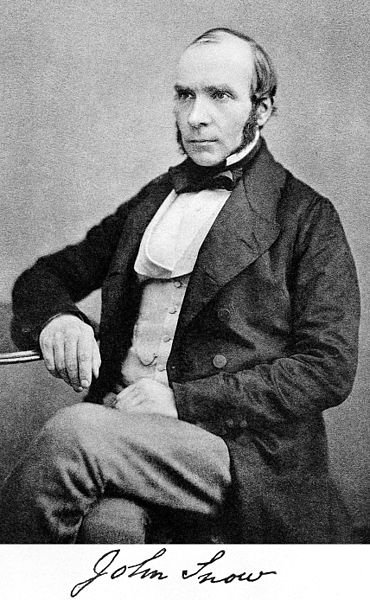
Armed with a detailed map of Soho, he marked all the deaths, as well as all the public water pumps, on the map. It didn’t take long to notice that most of the fatalities were clustered around one particular water pump, on Broad Street (now called Broadwick Street). His data included some outliers, but through personal interviews (contact tracing) he was able to tie those cases to that same pump.
This was proof enough for Dr. Snow, and he was able to get the handle removed from the pump so it could not be used. That doesn’t mean that suddenly this particular public health issue was solved and cholera was eradicated. However, between the pump being shut down and the fact that the majority of residents had already fled the area, this particular outbreak was stopped. Unfortunately it was not stopped before more than 600 people had died.
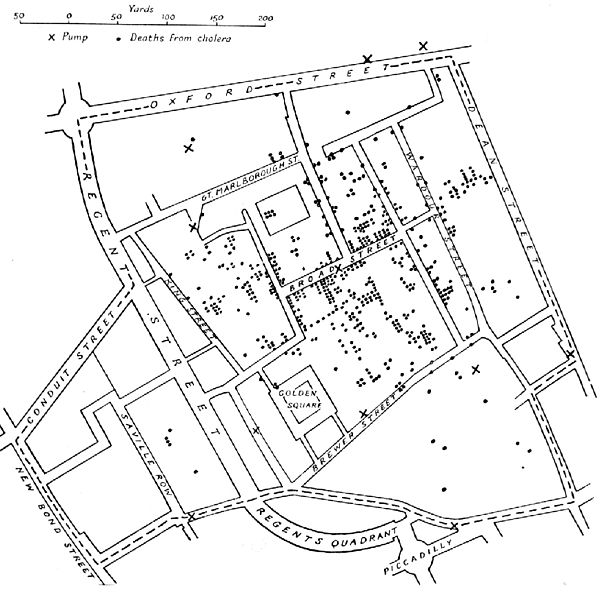
This is a simple story, but there was a lot more than that going on in my research and in my head.
- I found a recommended book I really want to read that expands this story to include more than the very basic facts that are available all over the web. This is a story that lends itself to short-form storytelling, but there is also much more depth available if you’re interested. Check out The Ghost Map: The Story of London’s Most Terrifying Epidemic…and How It Changed Science, Cities, and the Modern World by Steven Johnson.
- I’m a visual person, so I love it when maps are used to see patterns. While researching this story I’ve seen blog posts that focus on the map aspect of this story and about how Snow was a pioneer in plotting data points to solve a scientific problem. Apparently mathematicians and statisticians love his groundbreaking study.
- This story happened 162 years ago, but the differences in living conditions between then and now are obvious. No flush toilets. No convenient water faucets in your home. No concept of germs or how to avoid or get rid of them in order to keep yourself safe and healthy.
- This case is considered the foundation of epidemiology. Science has advanced so incredibly since that time. I hope that 162 years from now people will look back at our stories with the same sense of pride in how much they’ve learned. And possibly amazement at our disgusting standards of living.
- “Gross” history is the best way to start teaching kids to like history.
- There’s a personal aspect here, which always makes it easier for me to remember history stories. When my daughter and I were in London earlier this year, we stayed four nights about three blocks from the site of the Broad Street pump, which is near Carnaby Street. Even though I knew the story, I had no idea I was in the neighborhood where it happened, even though we wandered around for days. There used to be a replica pump in place for those of us interested in history, but it was removed recently to make way for new construction.

- Even though we know the cause of something (like cholera) and even how to fix it (like cholera), that doesn’t necessarily mean that it gets fixed. People still die today from cholera. We’re not as advanced as we’d like to think.
- And lastly, something that you’d think would be a no-brainer. DON’T FOUL YOUR WATER SUPPLY!
Also, WASH YOUR HANDS!
Mary Mallon, Typhoid Carrier
I hope you all are staying well. I read that in Iceland they are testing everybody for the coronavirus, not just those who present with symptoms. Although they haven’t tested the entire population yet, they have discovered that about half of those who tested positive were asymptomatic.
That’s right, lots of people who haven’t shown symptoms or been tested (don’t get me started on that) are carrying the virus. And can share the virus with others.
So this week I’m going to introduce you to Mary Mallon, otherwise known as Typhoid Mary. She’s known as the first asymptomatic carrier of typhoid.
First, typhoid fever is a bacterial infection. It can only spread where human feces come into contact with food or water. So people should wash their hands, be careful about where they prepare food, and know the source of their drinking water.
Starting around 1900, Mallon (1869-1938) worked as a cook in New York City, working for mostly wealthy families that could afford their own cook. She moved from household to household, never staying long, leaving a trail of sick people behind.
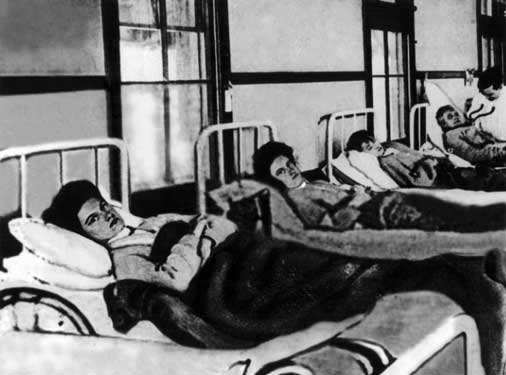
In 1906, one of the families who had suffered from typhoid hired a researcher to find the source of their outbreak. He found that the family had hired a new cook just before their outbreak and she had since moved on.
Once a possible carrier was identified, the researcher eventually located Mallon due to another outbreak in her latest place of employment. When she refused to be tested, he investigated her work history and found that almost all previous families claimed to have suffered from typhoid fever around the time she worked for them.
Even though Mallon refused to be tested, it was determined that she was a carrier of the disease. Because she refused to be tested and refused to give up her work as a cook, she was held in isolation at a hospital.
After three years in quarantine, she was allowed to leave if she agreed to practice better hygiene and to quit working as a cook.
After her release she worked as a laundress. But that simply did not pay as much as working as a cook.
So she changed her name and went back to cooking. She never stayed long in any one place, and she almost always left a typhoid outbreak in her wake. And this was the early 20th century and it was a lot harder to find someone who didn’t want to be found.
Until 1915, when she started an outbreak at a hospital in which two people died. The police finally found her after that one.
This time she was confined to a hospital from 1915 until her death in 1938. There is no way to know for sure how many people became ill and how many died due to Mallon, but she spent more than a third of her life locked up to prevent any more.
If you are a fan of Anthony Bourdain and enjoy his signature style of storytelling, check out his book Typhoid Mary: An Urban Historical.
And remember, just because you’re not sick doesn’t mean you can’t get other people sick. Also, wash your hands.
Contact Us
Contact us today with questions or concerns!
760-908-0292
Cathy@
